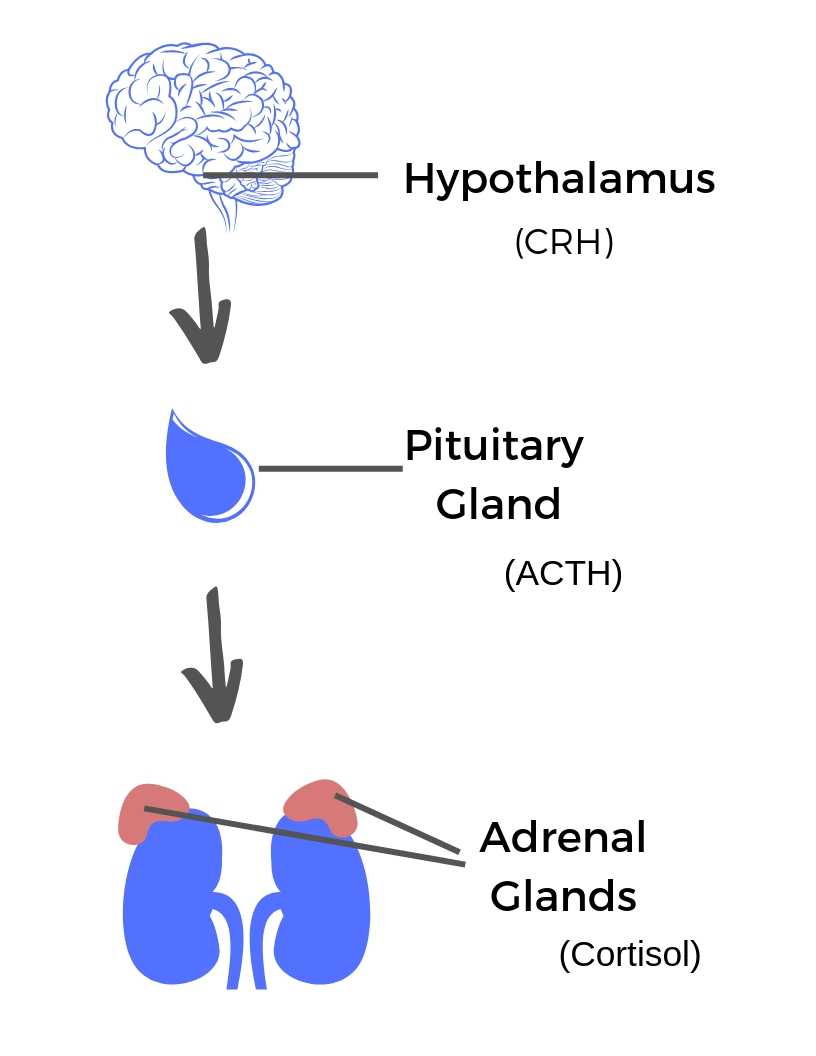Need to lose weight? Just eat less and exercise more, right?
If that’s all it took, there would not be nearly as many people struggling to get the extra weight off. If you’ve dealt with stubborn fat loss at all, you’ve probably tried that method. And maybe it even worked for a time! But as soon as you stop regulating your calories and skip a few workouts the pounds creep back on.
I’ve already written a bit about why fat loss is more about hormones than calories but let’s dive a bit more into that from a different angle.
If you have tried all the different diets, eaten less and moved more, tracked every morsel that has passed your lips and still struggle with excess body fat then it’s probably time to look deeper into what messages your brain is sending your body via your HPA axis.
The HPA axis is the body’s connection of the central nervous system and endocrine system. It consists of the hypothalamus, pituitary, and adrenal glands.
The hypothalamus is a small region of the brain that coordinates hormone production and facilitates that connection of the endocrine and nervous system. It is involved in many essential functions of the body. Achieving wellness and balance in the body will always involve the hypothalamus.
The pituitary gland is often referred to as the “master gland” because it takes messages from the hypothalamus in the brain and either stimulates or inhibits hormone production in other endocrine glands.
The adrenal glands sit on top of the kidneys and are responsible for producing and releasing hormones that regulate water and sodium in the body, some sex hormones, and our stress hormones, including cortisol. Cortisol is a necessary hormone for human function but when we are constantly experiencing stress, the negative feedback loop that the body uses to control cortisol and other hormone production gets desensitized.

How the HPA axis is supposed to work
Under normal circumstances, if our brains perceive some sort of environmental or metabolic stress, the hypothalamus sends Corticotropin Releasing Hormone (CRP) to the pituitary gland which responds by sending Adrenocorticotropic Hormone (ACTH) to the adrenal glands. The adrenal glands respond by producing and releasing cortisol, norepinephrine, and epinephrine (adrenaline), which have a few jobs. They cause an increase of glucose into the blood to supply energy and increase heart rate and blood pressure. These hormones are intended to provide that fight or flight response to get you through the stressful event.
How the HPA axis gets “gummed up”
The problem is that our lives are basically one big long stressful event, whether we realize it or not. You may feel like you have a good handle on your stress levels but there could be underlying issues or ways that your HPA axis has become dysregulated that you do not realize. The over-stimulation of the hypothalamus keeps our brains and bodies in a constant state of high alert. Our brains always think that a stressful event is taking place that requires extra energy. Constant release of hormones that increase fight or flight will suppress hormones responsible for the body’s ability to “rest and digest.” Your brain will always think you need the energy necessary to run from a tiger even if all you’re doing is sitting at a desk all day.
We can categorize the ways in which our bodies are stressed into four main categories: mental/emotional (also called perceived stress), circadian disruption, metabolic or glycemic dysfunction, or chronic inflammation (1).
Mental/Emotional Perceived Stress:
These are any triggers that your brain finds stressful. Finances, childhood trauma or bad memories, work stress, traffic, grief, fear, anxiety, public speaking, etc. There are so many experiences and situations that can stress the brain. These are “perceived” because it is how you personally perceive the trigger that affects your body’s response to it. Some of these stresses are occurring on a daily basis and can be negatively impacting the HPA axis.
Circadian Disruption:
Our bodies follow a basic 24 hour cycle of certain physical and mental changes. Light and darkness trigger many of these but we are surrounded by things that interrupt this process. Screens, fake light, lack of exposure to morning light, busy schedules, etc. get in the way of our natural circadian rhythm. This is a stress on the brain, which in turn causes strain on the HPA axis.
Glycemic Dysfunction:
This is your body’s inability to regulate blood sugar. Improper diet, lack of sleep, and lack of adequate movement can affect your HPA axis but also your body’s ability to maintain proper blood sugar. Low blood sugar, high blood sugar, and blood sugar swings are all a stress on the body and can cause an increase in those stress hormones. When we continually eat foods that cause high blood sugar, we keep ourselves in a state of stress.
Chronic Inflammation:
In situations of acute stress, cortisol acts as an anti-inflammatory. Chronic activation of cortisol will end up suppressing the immune system and encourages the body to stay in a state of inflammation. If the hypothalamus is perceiving some sort of chronic stress, the body will continue the production of cortisol to try to dampen the inflammation. There are many sources of chronic inflammation that you may be experiencing in your body that you don’t even realize. Gut infections, food sensitivities (known or unknown), or any sort of inflammatory disease can lead to HPA axis dysregulation.
So what does this mean if you’re trying to lose weight?
It means that you have to look at all areas of your life and in what ways your body may be experiencing stress. You can eat less food and exercise more but that may very well be adding to the problem. You need to eat foods that are going to send the right signals to your brain and body, you need to do the right kind of movement that is going to cause some stress but not too much, you need to find ways to relax and recharge, you need to do what you can to get adequate sleep (mamas, I know this isn’t always possible!), and you need to address sources of inflammation in your body that may be underlying.
Some practical ways to support the HPA axis and encourage weight (fat) loss:
- Avoid inflammatory foods: gluten, dairy, soy, sugar, and all grains if you are really struggling
- Move your body in gentle ways like long walks, yoga, stretching, etc.
- Get tested for small intestine bacterial or fungal overgrowths like SIBO that could be triggering chonic stress responses
- Expose yourself to sunlight first thing in the morning if possible and avoid screens a few hours before bed (no, I am not good at this one!). You could at least try some blue light blocking glasses to dampen the negative effect of the blue light
- Laugh and have fun! This may seem silly, but it is so true. The more time we spend focusing on stressful things or thoughts that make us anxious, angry, or unhappy, the more we are activating a negative stress response. Find ways to have fun and laugh every day!
- Take breaks from working at your computer. Get up, move, stretch, go for a walk. Screens are a stress on our eyes and brains as well, so taking a break from them is important!
It may be tempting to blow a lot of this off. We want quick fixes and magic pills. But if you are struggling to lose weight or keep it off and feel like you’ve tried everything, you must look at all of these ways that stress may be impacting your brain and body. You are wired to survive. Your body has many processes in place to make that happen and our modern lifestyles don’t interact well with many of those processes. Consider taking a new look at how you approach your attempts to change your body and please reach out to me if you’d like to chat more specifically about how to make that happen!
